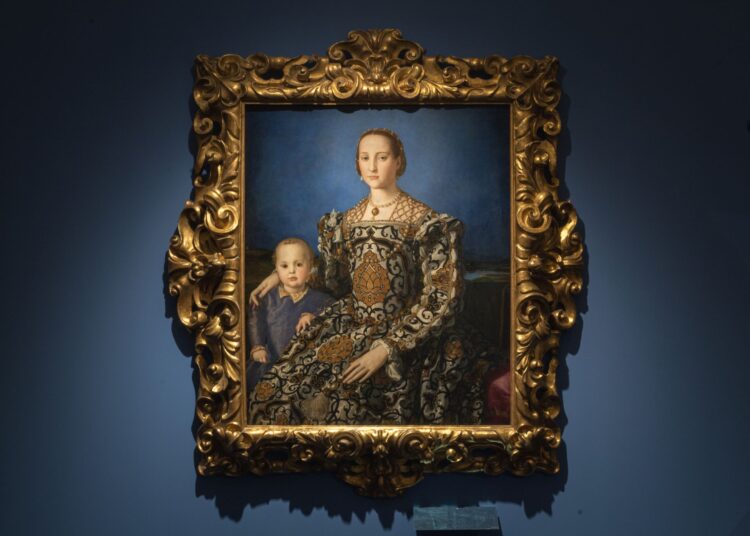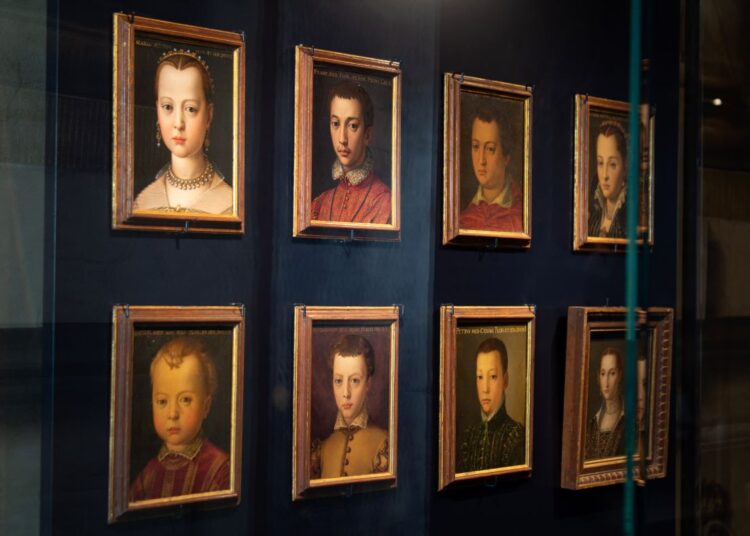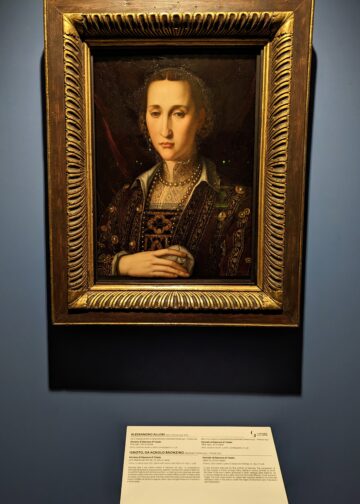On until May 16 in the Palazzo Pitti’s frescoed “Treasury of the Grand Dukes” is the Uffizi’s first 2023 mega-exhibition: Eleanora di Toledo and the Invention of the Medici’s Florentine Court.

Elke Schmidt, the Museums’ Director, began the press preview on February 6th with this heart-warming announcement: “A good beginning bodes well. We’ve started off 2023 on the right foot. In January 282,532 tourists visited the Uffizi Galleries, not only 110% more than the same month in 2022, but 28% more than in January 2019. That year we’d counted the record number of visitors ever at 4.4 million. Now our goal is to break 2019’s record.”
From February 7th over one hundred works-of-art: paintings, sculpture, drawings, tapestries, historical costumes, gems, and jewelry will celebrate the life and cultural importance of Eleanora di Toledo (1522-62), one of the most noteworthy women of the Italian Renaissance.
Spanish-born and raised in Naples, charismatic, yet a deeply pious devotee of Ignatius of Loyola, Eleanora’s impact on Florence can still be seen today thanks to her patronage of the arts. As a very young bride in 1540 she oversaw the remodeling of her apartment, complete with frescoes of famous women by Vasari, and of her private chapel decorated by Bronzino, her favorite painter, both in the Palazzo Vecchio.

A decade later she purchased with her own funds Palazzo Pitti and the land, which would become the Boboli Gardens, across the Arno. Her excuse was to provide a healthier environment to bring up the 11 children (three died as babies) she bore to her said-to-be ever-faithful husband Cosimo dei Medici (1519-74), whose branch of this powerful dynasty would otherwise have died out. Sadly, because of her weak health, a consequence of her frequent pregnancies and chronic tuberculosis, she didn’t see this latter renovation project completed, dying of malaria at age 40.
An avid gambler, a nature lover and passionate traveler, moving frequently from one Medici estate to another, she was an icon of beauty, a fashion innovator and trendsetter immortalized in several of Bronzino’s portraits on display here. She was also a keen businesswoman financing many of her husband’s political campaigns. Not to omit, that as powerful political leader, she ruled as regent of Florence during Cosimo’s frequent absences: his military campaigns in Genoa in 1541 and 1543, his illness from 1544 to 1545, and again at times during the conquest of Siena (1551-4).
The exhibition, curated by Bruce Edelstein, Professor of Art History at NYU’s Florence campus, is divided into 7 sections: “Eleanora’s Childhood at the Court of Naples” where her father Pedro de Toledo was viceroy. His portrait by Titian (1642) on loan from Munich’s Alte Pinakothek is the key work here.
The festivities of her “Arrival in Florence” are evoked here through drawings and musical scores as well as from several rings, certainly wedding presents from Cosimo, found in her tomb in the Basilica of San Lorenzo during her exhumation in 2004.

“Eleanora’s Eleven Children” contains the star of the exhibition: Bronzino’s “Portrait with her son Giovanni” (c. 1545), in the Uffizi. One of several copies painted by Bronzino, it epitomizes its subject: her determined and no-nonsense expression; her elegance; beautiful jewels; her magnificent brocaded silk and velvet dress embroidered in Spain with pomegranates, a symbol of fertility; her son Giovanni, Cosimo’s heir, at her side to show future continuity; and a lighter shade of blue in the background around her head as if a halo. It was long believed, until the exhumation proved otherwise, that she’d been buried in this dress, although a similar hairnet with pearls was uncovered.

The key work of “Eleanora and Art” is a tapestry woven in the atelier of Nicolas Karcher, after a cartoon by Francesco Salviati, Lamentation. It probably hung in the Palazzo Vecchio’s chapel before Bronzino painted its altarpiece.
“Fashion Icon the 16th Century Florence” concerns Eleanora’s detail not only to her own wardrobe but also to her sons’. “Her Love of Gardens and the ‘Creation’ of Boboli” points out that her love of gardens and life outside the city was closely connected to her economic strategy aimed at significantly increasing Medici landholdings, which were lucrative through the cultivation of grain.
“Eleanora’s Legacy” concerns her posthumous pious image and her legacy: a monastery for noblewomen dedicated to the Immaculate Conception on Via della Scala. The key work here is her posthumous portrait (1562), attributed to Alessandro Allori and loaned by the Staatliche Museen zu Berlin, Gemäldgalerie.
The majority of the artifacts on display belong to the Uffizi Galleries and other Florentine, Tuscan and Italian museums, archives, and libraries. American lenders are: Baltimore’s Walters Gallery, Harvard’s Fogg Museum, the Getty, Washington D.C.’s National Gallery, Raleigh’s North Carolina Museum, and Philadelphia’s Museum of Art.












